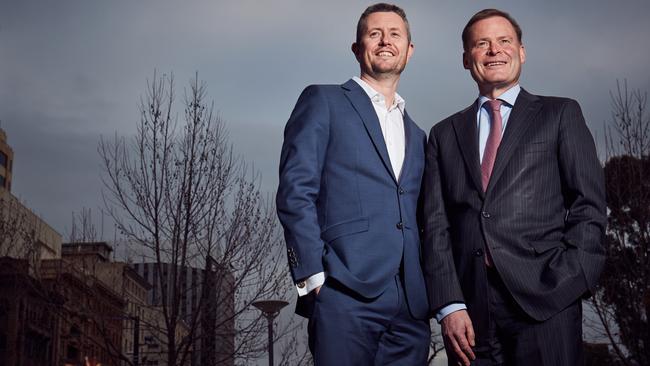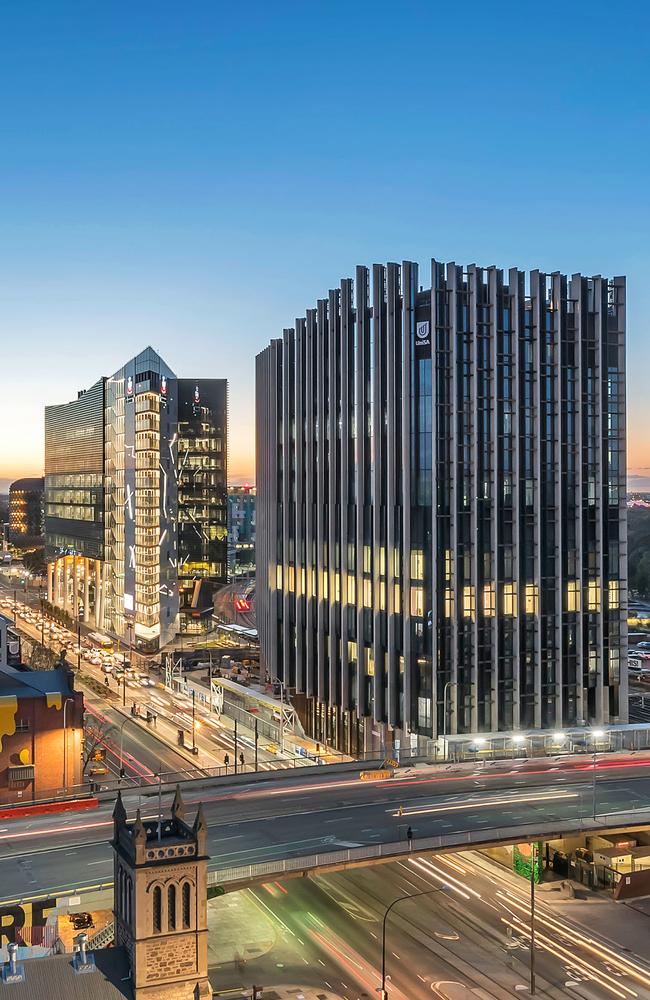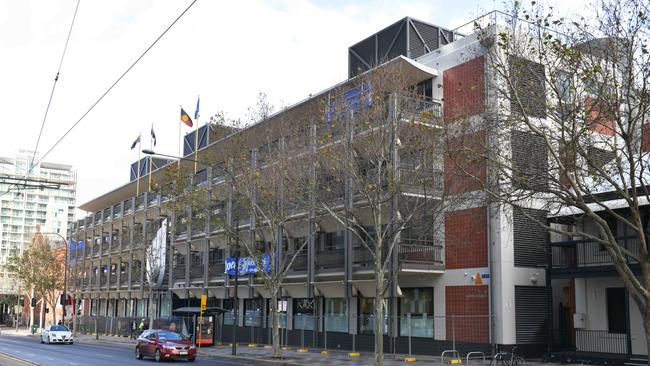Proposed merger between Adelaide Uni and UniSA would make us a city of innovation, vice-chancellors say
A SUPER university created by a merger would help Adelaide shake its tag as the “City of Churches” and become renowned for innovation instead, Adelaide Uni boss Peter Rathjen says.
SA News
Don't miss out on the headlines from SA News. Followed categories will be added to My News.
- Adelaide University and UniSA to officially explore merger
- How it could make Adelaide the next-level modern metropolis
- A merge was suggested as early as 2012...
- ... and debate was reignited in March this year
A SUPER uni created by a merger would help Adelaide shake its tag as the “City of Churches” and become renowned for innovation instead, Adelaide University boss Peter Rathjen says.
UniSA and Adelaide University will today release a discussion paper on the merger proposal, outlining a vision for Adelaide to be the “pre-eminent higher education city in Australia”.
The vice-chancellors of the two unis say the northern part of the Adelaide CBD has unique geographical advantages for the creation of a “university city”, if the clout of a larger university was combined with the scientific, cultural, political and sporting institutions either side of North Tce.
The report from consultants Nous says a merger would transform that part of the city into “a cultural and educational epicentre that brings together, advances and shares with South Australia the best cultural, economic, political and academic minds from across the state, country and globe”.
“Combined city campuses could create disciplinary precincts that make the most of government investment and combine and further develop areas of excellence and extend Adelaide as a vibrant city built around the university campuses,” it says.

The discussion paper provides the first detailed exposition of the arguments for and against a merger since the unis in June announced they were exploring the move.
It says a merger could deliver a boon in attracting research funding and top academic talent, while boosting capacity to collaborate with industry by bringing together Adelaide University’s strengths in pure research with UniSA’s applied research expertise. A merger could also result in new course offerings.
But the report warns a merger could also prove too costly, too difficult, damaging to culture and tradition, and potentially put at risk the student market share.
While the report does not contain modelling on the economic impacts of the move, Prof Rathjen was convinced, at least so far, that a larger institution could deliver on the advantages it outlines.
“This is the time for Adelaide to break away from being the City of Churches and become a city of young people and vitality and diversity,” Prof Rathjen said.
“The great drivers of the next wave of socio-economic innovation will be universities.
“We know we will have to extract far more from knowledge and innovation industries. The great universities can do this at a scale which is transformative … act(ing) as stronger attractors of talent, be that staff or students or corporations. We think SA needs something better than we are able to offer at this (current) scale.”
However, Prof Rathjen said the cost of a merger and the challenge of creating a new culture were potential “showstoppers” that could make an amalgamation unfeasible.
“We don’t understand the cost of putting two institutions together yet,” he said.
“Is there really a fundamental difference in the culture of the two organisations? Is that an irreconcilable difference? Can we build a culture that reflects the strengths of both?”
UniSA Vice-Chancellor David Lloyd agreed there was the opportunity for “two good institutions to be a better institution”.
“If you can get the attributes of this institution right from the start, this can be a game changer for the state,” he said.
“The (bigger) scale is really important to reach the level of excellence and access that we are talking about.”
Prof Lloyd said UniSA’s new cancer research centre and Adelaide Uni’s new medical school, side by side on North Tce at a combined cost of half a billion dollars, were good cases studies for the benefits of a merger. A merged uni would have built one building for $350 million and spent the rest investing in academic talent or other priorities, he said.

Prof Lloyd said joining the unis’ two engineering faculties could create one of the best in Australia, which in the context of booming SA defence and aerospace industries would be a “massive advantage”.
He also stressed the benefits would not be confined to the CBD, but would also be felt at campuses across SA: “Regional education is central to both our ideals about the future of education in SA.”
But Prof Lloyd worried that the different demographic bases attracted to UniSA and Adelaide University might be alienated under a merger if not handled carefully.
“There is a risk that we put two institutions together and impact on student choice,” he said. “The good idea need not always be the right idea.”
The vice-chancellors stressed neither uni was in a financial position to need an amalgamation, so were in an ideal position to assess its merits objectively. Public submissions on the merger are due by September 21. A more detailed interim report will then be put to the two unis’ academic councils. The councils will consider a final report in December before making a decision. State Parliament would have to approve the move.
READ THE FULL REPORT
ADVANTAGES
A UNIVERSITY CITY
The new uni, alongside the cultural institutions of the Adelaide CBD, could “develop that area of the city into a cultural and educational epicentre” attracting the best talent from around the world.
Combined city campuses could create “disciplinary precincts”, such as in health, to maximise the benefits of government investment.
RESEARCH CAPACITY AND PERFORMANCE
A merger would combine Adelaide’s strength in pure research with UniSA’s applied research profile.
The larger revenue base would enable greater funding of research, so the new uni would be better placed to attract world class researchers, whose work would have greater economic and social impact.
EXPANDED COURSE OFFERINGS
For example, combining degree and course choices from UniSA’s Art, Architecture and Design School with Adelaide’s Faculty of Arts and Elder Conservatorium of Music could create more options in visual and performing arts. A merged uni could offer a wider array of language degrees as well as more online courses through the well-established UniSA Online platform.
GREATER ACCESS FOR STUDENTS OF LOW SOCIOECONOMIC BACKGROUND
The new uni could offer more pathways into tertiary study, including more scholarships for students from regional and remote areas, Aboriginal students, students with disabilities, and those in financial hardship. The combined network of regional campuses could allow more students to remain close to their families and communities.
COLLABORATION ACROSS DISCIPLINES
More opportunities for cross-disciplinary collaboration and more influential industry partnerships.
Combining Adelaide’s School of Medicine with UniSA’s allied health disciplines could create “a leading medical and health powerhouse”. Similarly, the merging of the two engineering schools could play a bigger role in aiding the growth of the defence and aerospace industries.
STAFF BENEFITS
For academics, greater capacity to forge international research partnerships and more opportunities for professional development in teaching. For admin staff, there would be “ a greater variety of challenging roles and career progression opportunities” within a larger and more complex organisation.

CHALLENGES AND RISKS
LESS PERSONAL
It could be harder to offer a personalised experience for staff and students within a much bigger organisation.
LOSS OF TRADITION, IDENTITY, REPUTATION
Adelaide has been around 140 years, with a strong brand, traditions and research reputation. UniSA has an identity as a top “young” institution. Impact of loss of identity and culture on staff and alumni are key considerations.
INABILITY TO FOCUS ON DIFFERENT STUDENT MARKET SEGMENTS
Adelaide attracts more high-ATAR students while UniSA has a strong equity focus. “There is a risk the new institution might not successfully manage the need to attract a wide range of students across multiple market segments, and hence lose market share.”
COST
The scale of investment required for a merger may outweigh the benefits. Focus on a merger could delay other key strategic initiatives and could cause the two unis to drop the ball on “business as usual” activities.
MERGERS ARE HARD
Mergers of large, complex organisations are difficult. There are multiple risks in integrating leadership, staff, courses, infrastructure, IT systems and processes. Realising the potential of the two unis’ complementary research profiles will be easier said than done.
IT MIGHT TAKE TOO LONG
Slow implementation would risk the merger never being finalised and the benefits never fully realised. But hasty implementation might jeopardise the long-term benefits.
WORLD RANKINGS MAY FALL AT FIRST
The goal is to create a world top 100 uni and reap the associated benefits of attracting talent and research funding, but rankings could slip in the short term before improving.
CHANGE IN STAFF PROFILE
The goal would be to grow both academic and admin staff numbers over time, be there would be an inevitable initial shake-up. Some staff would have to take on specific short-term roles to implement the merger.
LACK OF POLITICAL SUPPORT
Both sides of politics at state and federal level have encouraged the merger discussions, but will they back it when it comes to the crunch? Changes in funding policy could also affect the structure and offerings of the new uni.


